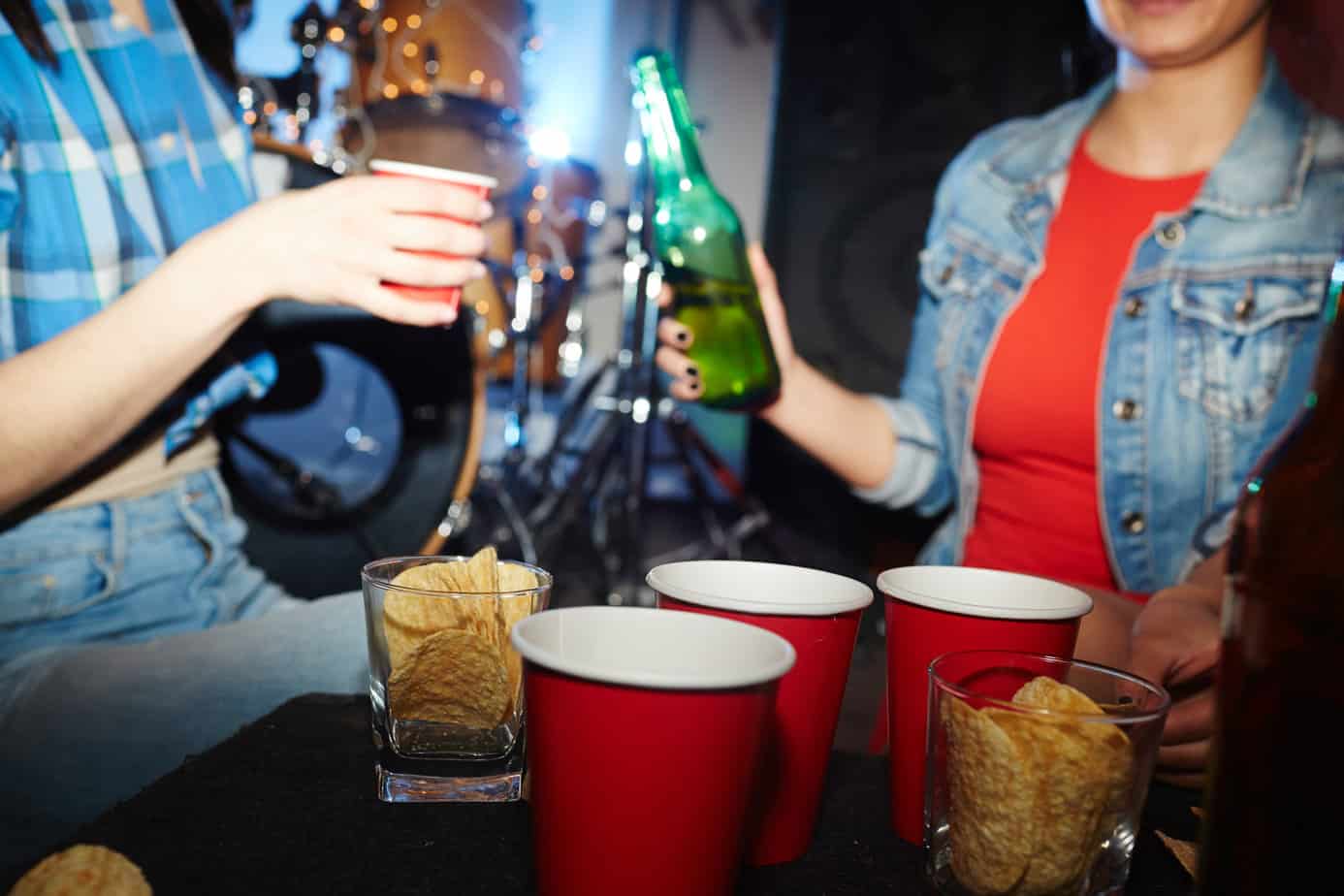BORGs, also known as “blackout rage gallons”, are the newest party staple popping up across college campuses. BORGs are a mixture of half water, half vodka, a flavored caffeinated beverage, and electrolyte powder. Because of the mix, many young adults are calling this TikTok trend a “hangover-proof” drink. Although some experts view this as a clever way to practice harm reduction and take ownership of one’s choices, others are worried that this is just normalizing binge-drinking habits.
Understanding BORG Drinking
A BORG is a gallon jug, filled halfway with water and a large amount of alcohol, typically in the form of a fifth (750 mL) of vodka. It is often mixed with flavor enhancers, such as a drink mix, and electrolyte powder to make it more palatable. The appeal of BORG drinking lies in its perceived safety measures, such as reducing the risk of drink spiking and providing a personal, sealed container. Some proponents of BORG drinking claim that it can also reduce the likelihood of hangovers and other negative side effects of alcohol consumption by keeping the individual hydrated and diluting the alcohol by placing it in a jug of water. This is why some call it a harm reduction strategy—but is it?
The Risks of BORG Drinking
Despite the perceived benefits, BORG drinking is far from safe. The National Institute of Alcohol Abuse and Alcoholism defines a standard drink as containing approximately 14 grams of pure alcohol. In an average BORG, a fifth of alcohol is equivalent to 17 shots. This substantial amount of alcohol can lead to severe intoxication and increase the risk of alcohol poisoning. Additionally, the unmeasured pouring of substances into a BORG can result in individuals unknowingly drinking alcohol in even higher quantities of alcohol.
Effects on the Liver
The liver plays a crucial role in metabolizing alcohol. It can process approximately one ounce of alcohol per hour. When large amounts of alcoholic beverages are consumed, the liver becomes overwhelmed, leading to a backlog of alcohol in the bloodstream and surrounding tissues. Contrary to popular belief, drinking water or using electrolyte enhancers does not speed up the liver’s ability to metabolize alcohol. The liver metabolizes alcohol at the same rate, regardless of the amount consumed.
Dehydration and Hangovers
While BORG drinking may contain a significant amount of water, it does not prevent dehydration or hangovers. Alcohol is a diuretic, causing increased urine production that leads to dehydration. Even if an individual drinks a large volume of fluid from a BORG, the dehydrating effects of alcohol can still occur. Furthermore, hangovers are caused by various factors, including the toxic byproducts of alcohol metabolism, inflammation, and disruption of sleep patterns. Diluting alcohol with water does not eliminate these factors and does not prevent hangovers.
Alcohol Poisoning and Health Risks
BORG drinking poses a significant risk of alcohol poisoning, especially when consumed in excessive amounts. Alcohol poisoning can result in symptoms such as hallucinations, dizziness, loss of consciousness, difficulty breathing, and nausea and vomiting. In severe cases, it can be life-threatening. Moreover, binge drinking, including BORG drinking, can lead to long-term health consequences such as liver damage, pancreatitis, and an increased risk of developing alcohol use disorder (AUD).
Chat with the Experts About BORGs
We also did a Q&A with Mountainside’s Outpatient Regional Director Courtney Hulse, LMFT, to get a clinical perspective on the growing trend. Below is what she had to say:
1. Why do some people view BORGs as a harm reduction strategy?
To start, while I don’t argue that there are certain harm-reducing aspects of this method, I believe it depends on the lens through which we are viewing it. For one, you can control what goes into a BORG rather than drink from the communal jungle juice made with various liquors often found at college parties. But just because you know you put 8 shots of vodka into your BORG, doesn’t make it any safer than a mixed gallon with 17 shots.
Also, the risk of someone tampering with another’s beverage, for instance, is lower, but there are greater risks in this popular binge drinking trend worth understanding before labeling it as a “harm-reduction” practice.
2. Why are teens drinking BORGs? What is all the hype about?
The name alone speaks volumes: Blackout Rage Gallon. College students are creating their own flavored alcoholic gallon-sized drinks, tailoring them to their own tastes, and the kicker – have less of a hangover the next day! According to Bustle, there is also an entire BORG culture to get behind where people are going a step further and giving their BORGS quirky names like “Cyborg” or “Spongeborg.”
Borgan donors even bring refreshments to the party. So with all this said, what’s not to love?
Answer: A lot, actually.
The idea behind this TikTok drinking trend is that it’s meant to have more of an impact on one’s intoxication (binge) with less of a consequence (hangover). Let that sink in for a second – more intoxication with less of a hangover.
For students mixing and drinking BORGS, that is the ultimate goal; get drunk fast and feel fine after. And while some experts acknowledge the benefits of including water and electrolytes in this process, we are failing to recognize that one of the main deterrents to dangerous binge drinking has now been removed – the dreaded hangover.
3. If BORGs supposedly eliminate the hangover the next morning, why is this a negative thing?
The idea that this process is that of a harm-reduction model is teaching teens and young adults that, “If I binge drink but hydrate my body with x amount of water and electrolytes, I’ll be fine the next morning.” The truth is, no matter how much you hydrate your body with water and electrolytes, alcohol is still a depressant and has a severe impact on a person’s body – especially if consumed in excess.
Binge drinking is binge drinking; hangover or no hangover. Whether you stayed fully hydrated throughout the night or not, you still consumed a potentially toxic amount of alcohol in a short period of time. While any amount of alcohol can be added to a BORG, most videos on social media recommend adding approximately 25.4 fluid ounces of liquor to each BORG. So, maybe you poured 25.4 fluid ounces into your BORG one night and felt fine the next day. Next time around, you consume 30.4, the following, 35, and so on. If there’s no hangover, what’s the worst that can happen?
4. What happens when you add too much alcohol to a BORG? What are the effects of binge drinking?
First off, everyone is different, which means alcohol affects each person differently. In the case that you consume an excess of liquor, you’ll likely experience alcohol poisoning/overdose, raised tolerance, alcohol-induced blackouts, or worse. Some of the short-term effects you may experience include:
- Headache
- Nausea and vomiting
- Loss of coordination and perception
- Impaired judgment, which may increase the chance of risky behaviors
- Injuries
- Violence
BORGs promote harmful binge drinking behaviors that teach impressionable minds it’s cool or “safe” to consume alcohol at high levels. Over time, this can lead to lasting consequences like alcohol dependence and substance use disorder as well as medical complications and issues down the road. Other long-term effects of binge drinking are:
- Weakened immune system
- Liver cirrhosis
- High blood pressure
- Digestive issues
- Increased risk of depression or anxiety
- Throat, esophagus, breast, and colon cancer
5. How should we shift our perspectives on BORGs?
By looking at the reduction of hangover effects we are focusing on the wrong problem; we’re trying to manage the symptoms associated with binge drinking (hangover) which will likely only perpetuate the ongoing pattern of binge drinking itself. Instead of focusing on symptom management of binge drinking, we need to focus on providing awareness of the effects of it while establishing healthier relationships with alcohol.
If you or a loved one is struggling with addiction, Mountainside can help.
Click here or call (888) 833-4676 to speak with one of our addiction treatment experts.

 By
By 







